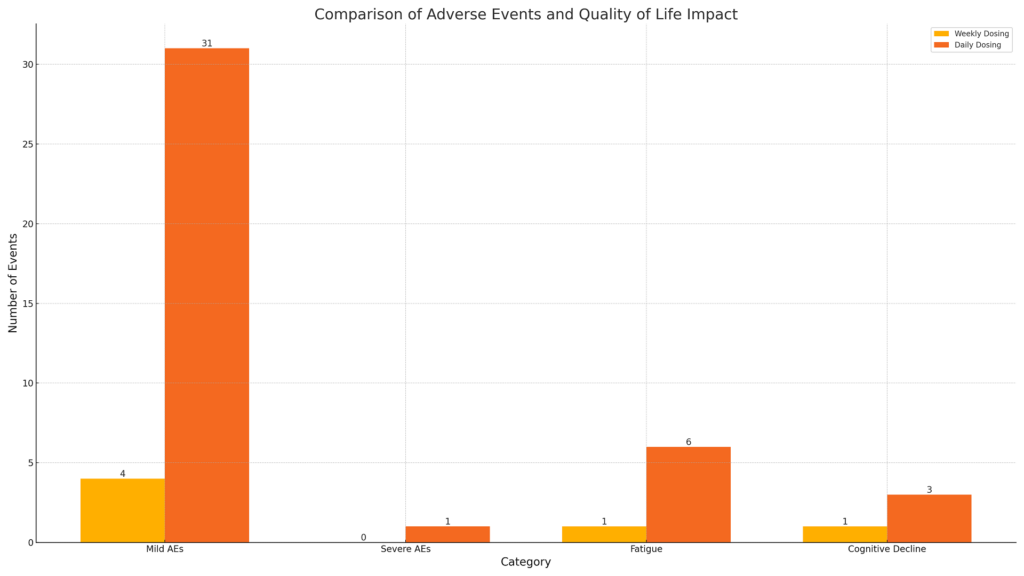Phase I Trial: Can New Rapamycin Tests Slow Down Early Prostate Cancer?

No approved therapies prevent the progression of early prostate cancer—yet! Image by Jan Bergman
- Phase I trial of encapsulated rapamycin (eRapa) in early prostate cancer patients under active surveillance to assess safety and tolerability.
- Early trial results show eRapa to be well-tolerated in patients, with most side effects being only mild and short-lived.
- Weekly dosing of eRapa appears to promote positive immune responses while minimally affecting the patient’s quality of life.
- Daily dosing of eRapa, while showing potential immune system benefits, also increased fatigue and other side effects in some patients.
Early Prostate Cancer Trial Has Promising Signs
The purpose of this Phase I trial was to see if encapsulated rapamycin (eRapa) is safe for men with early signs of cancer. That involved closely monitoring patients at low or medium level risk. Dr. Phillip Kemp Bohan at Brooke Army Medical Center led the study. The primary aim was to find new ways to treat or even slow down the growth of cancer. The experiment ran from August 2018 to June 2019. It involved 14 patients who were given different doses of eRapa over six months.
The results suggest that eRapa may be a safe way to boost the immune system’s response to this type of cancer. If larger studies with more people back this up, eRapa has real potential to help improve the effectiveness of active surveillance (close monitoring).

Doses and Goals
Here’s how the team set up this experiment using eRapa for prostate cancer.
Single Location
This Phase I early cancer trial took place at one medical center.
Open Design
Everyone involved, i.e., doctors and patients, knew what drug was being tested.
Gradual Increase
The study split the patients into three groups. Each cohort received a different amount of eRapa: low dose (0.5mg), medium dose (1mg), or 0.5mg daily.
Safety Priority
The goal was to see if eRapa was safe to use, meaning no or minimal side effects for the volunteers. Beyond Safety: They also looked at other things (secondary objectives). That included how the drug affected the body’s natural defenses (immune response).
More on the Study’s Results
The Phase I trial of encapsulated rapamycin in men with early prostate cancer was encouraging. The study evaluated how the body handles the drug (pharmacokinetics). It also looked at safety, day-to-day living, and the body’s defense system (immunologic response).
Below is a summary of the key findings:
| Category | Key Findings |
|---|---|
| Safety and Adverse Events | Most patients (11 out of 14) had some side effects, but they were mostly minor and short-lived. Daily dosing caused more serious side effects in one person. Overall, weekly treatments resulted in fewer and less severe issues than daily dosing schedules. |
| Pharmacokinetics | eRapa dose resulted in higher peak levels in blood, meaning a greater concentration of the drug was achieved. Daily dosing kept these levels steady after 2-3 days (48-72 hours). |
| Quality of Life | The weekly dose was easy to handle. Daily dosing, though, caused tiredness and absent-mindedness. These effects went away soon after treatment. |
| Immunologic Response | Weekly eRapa boosted new immune cells. Daily use favored existing immune cells can cause fatigue in some people. |
Here’s a visual representation comparing the adverse events (AEs) and the impact of quality of life on weekly and daily eRapa dosing.

Discussion and Implications
To summarize, the trial found eRapa treatments to be safe overall. There were fewer side effects and a steadier impact on daily life when taken weekly. The study also suggests eRapa might help fight early prostate cancer, though more research is crucial. Because potential side effects vary between doses, the best way to take eRapa is still undecided.
Here are the pros and cons of both weekly and daily dosages.
Weekly Dosing of eRapa
Pros
- Well-tolerated by most patients
- Minimal side effects
- Stable quality of life outcomes
- Boosts new immune cells
Cons
- Requires consistent weekly administration
Daily Dosing of eRapa
Pros
- Helps the body remember how to fight off past threats
- May help to boost the immune system
Cons
- More side effects, including a Grade 3 toxicity (severe)
- Short-term thinking issues (transient cognitive decline)
- Increased fatigue
5 Limitations and Future Research
#1 Study Size: This was a small group, so these results may not apply to everyone.
#2 Early Stage: This was an early trial (Phase I). It focused more on safety than the usefulness against cancer itself.
#3 Missing Piece: The absence of a control (untreated) group taking a placebo (sugar pill) is a significant gap in the study design. That approach would have given a clearer effect of the drug.
#4 Looking Deeper: This trial didn’t deeply track how well the drug slowed early prostate cancer growth, e.g., no regular PSA tests and biopsies. There is an urgent need for wider-ranging tracking in the future.
#5 Optimizing eRapa: Researchers would also like to compare this form of rapamycin (eRapa) to others to see if it is the best option.
Future trials must involve larger groups in more controlled settings. This approach will give researchers a clearer idea of how eRapa impacts cancer progression.
In Closing
This phase I trial looked at the safety of encapsulated rapamycin to fight early cancer. Taking the drug once a week seemed safe and caused fewer side effects than taking it daily. The drug may also boost the patient’s immune system. A strong natural defense system is much better at identifying and eliminating abnormal cells (including cancer cells). These discoveries imply the drug is safe to use, which encourages future trials.
This news is exciting. It could mean that a new and better way to manage early prostate cancer, with fewer downsides, is on the horizon.





